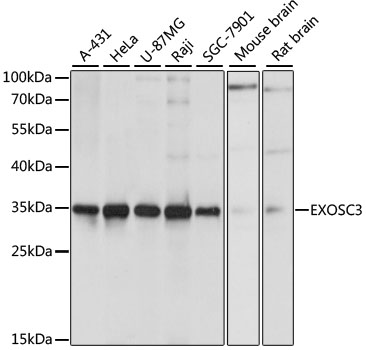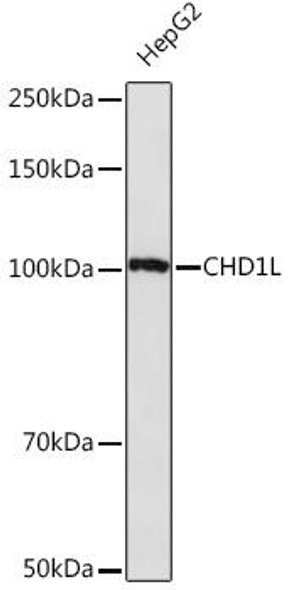Anti-EXOSC3 Antibody (CAB11623)
- SKU:
- CAB11623
- Product type:
- Antibody
- Reactivity:
- Human
- Mouse
- Rat
- Host Species:
- Rabbit
- Isotype:
- IgG
- Antibody Type:
- Polyclonal Antibody
- Research Area:
- Epigenetics and Nuclear Signaling
Frequently bought together:
Description
| Antibody Name: | Anti-EXOSC3 Antibody |
| Antibody SKU: | CAB11623 |
| Antibody Size: | 20uL, 50uL, 100uL |
| Application: | WB |
| Reactivity: | Human, Mouse, Rat |
| Host Species: | Rabbit |
| Immunogen: | Recombinant fusion protein containing a sequence corresponding to amino acids 1-275 of human EXOSC3 (NP_057126.2). |
| Application: | WB |
| Recommended Dilution: | WB 1:500 - 1:2000 |
| Reactivity: | Human, Mouse, Rat |
| Positive Samples: | A-431, HeLa, U-87MG, Raji, SGC-7901, Mouse brain, Rat brain |
| Immunogen: | Recombinant fusion protein containing a sequence corresponding to amino acids 1-275 of human EXOSC3 (NP_057126.2). |
| Purification Method: | Affinity purification |
| Storage Buffer: | Store at -20°C. Avoid freeze / thaw cycles. Buffer: PBS with 0.02% sodium azide, 50% glycerol, pH7.3. |
| Isotype: | IgG |
| Sequence: | MAEP ASVA AESL AGSR ARAA RTVL GQVV LPGE ELLL PEQE DAEG PGGA VERP LSLN ARAC SRVR VVCG PGLR RCGD RLLV TKCG RLRH KEPG SGSG GGVY WVDS QQKR YVPV KGDH VIGI VTAK SGDI FKVD VGGS EPAS LSYL SFEG ATKR NRPN VQVG DLIY GQFV VANK DMEP EMVC IDSC GRAN GMGV IGQD GLLF KVTL GLIR KLLA PDCE IIQE VGKL YPLE IVFG MNGR IWVK AKTI QQTL ILAN ILEA CEHM TSDQ RKQI FSRL AES |
| Gene ID: | 51010 |
| Uniprot: | Q9NQT5 |
| Cellular Location: | Cytoplasm, Nucleus, nucleolus |
| Calculated MW: | 17kDa/29kDa |
| Observed MW: | 30kDa |
| Synonyms: | EXOSC3, CGI-102, PCH1B, RRP40, Rrp40p, bA3J10.7, hRrp-40, p10 |
| Background: | This gene encodes a non-catalytic component of the human exosome, a complex with 3'-5' exoribonuclease activity that plays a role in numerous RNA processing and degradation activities. Related pseudogenes of this gene are found on chromosome 19 and 21. Alternatively spliced transcript variants encoding different isoforms have been described. |
| UniProt Protein Function: | EXOSC3: Non-catalytic component of the RNA exosome complex which has 3'->5' exoribonuclease activity and participates in a multitude of cellular RNA processing and degradation events. In the nucleus, the RNA exosome complex is involved in proper maturation of stable RNA species such as rRNA, snRNA and snoRNA, in the elimination of RNA processing by-products and non-coding 'pervasive' transcripts, such as antisense RNA species and promoter-upstream transcripts (PROMPTs), and of mRNAs with processing defects, thereby limiting or excluding their export to the cytoplasm. The RNA exosome may be involved in Ig class switch recombination (CSR) and/or Ig variable region somatic hypermutation (SHM) by targeting AICDA deamination activity to transcribed dsDNA substrates. In the cytoplasm, the RNA exosome complex is involved in general mRNA turnover and specifically degrades inherently unstable mRNAs containing AU-rich elements (AREs) within their 3' untranslated regions, and in RNA surveillance pathways, preventing translation of aberrant mRNAs. It seems to be involved in degradation of histone mRNA. The catalytic inactive RNA exosome core complex of 9 subunits (Exo-9) is proposed to play a pivotal role in the binding and presentation of RNA for ribonucleolysis, and to serve as a scaffold for the association with catalytic subunits and accessory proteins or complexes. EXOSC3 as peripheral part of the Exo-9 complex stabilizes the hexameric ring of RNase PH-domain subunits through contacts with EXOSC9 and EXOSC5. Defects in EXOSC3 are the cause of pontocerebellar hypoplasia type 1B (PCH1B). A severe autosomal recessive neurologic disorder characterized by a combination of cerebellar and spinal motor neuron degeneration beginning at birth. There is diffuse muscle weakness, progressive microcephaly, global developmental delay, and brainstem involvement. Belongs to the RRP40 family. 2 isoforms of the human protein are produced by alternative splicing. |
| UniProt Protein Details: | Protein type:EC 3.1.13.-; Nucleolus; RNA processing; Ribonuclease Chromosomal Location of Human Ortholog: 9p13.2 Cellular Component: cytoplasm; cytosol; exosome (RNase complex); nuclear exosome (RNase complex); nucleolus; nucleoplasm; nucleus Molecular Function:exoribonuclease activity; protein binding; RNA binding Biological Process: DNA deamination; exonucleolytic trimming to generate mature 3'-end of 5.8S rRNA from tricistronic rRNA transcript (SSU-rRNA, 5.8S rRNA, LSU-rRNA); isotype switching; regulation of mRNA stability; rRNA processing |
| NCBI Summary: | This gene encodes a non-catalytic component of the human exosome, a complex with 3'-5' exoribonuclease activity that plays a role in numerous RNA processing and degradation activities. Related pseudogenes of this gene are found on chromosome 19 and 21. Alternatively spliced transcript variants encoding different isoforms have been described. [provided by RefSeq, Jun 2012] |
| UniProt Code: | Q9NQT5 |
| NCBI GenInfo Identifier: | 14285758 |
| NCBI Gene ID: | 51010 |
| NCBI Accession: | Q9NQT5.3 |
| UniProt Secondary Accession: | Q9NQT5,Q5QP85, Q9Y3A8, A8K0K6, |
| UniProt Related Accession: | Q9NQT5 |
| Molecular Weight: | 30kDa |
| NCBI Full Name: | Exosome complex component RRP40 |
| NCBI Synonym Full Names: | exosome component 3 |
| NCBI Official Symbol: | EXOSC3 |
| NCBI Official Synonym Symbols: | p10; PCH1B; RRP40; Rrp40p; CGI-102; hRrp-40; bA3J10.7 |
| NCBI Protein Information: | exosome complex component RRP40 |
| UniProt Protein Name: | Exosome complex component RRP40 |
| UniProt Synonym Protein Names: | Exosome component 3; Ribosomal RNA-processing protein 40; p10 |
| Protein Family: | Exosome complex component |
| UniProt Gene Name: | EXOSC3 |








